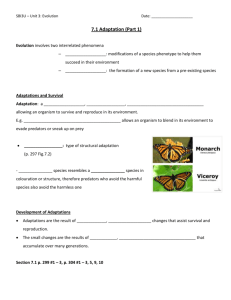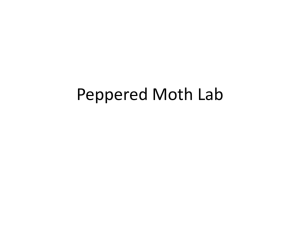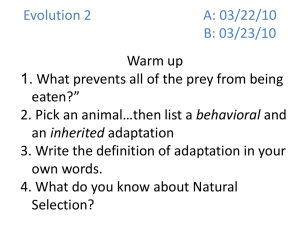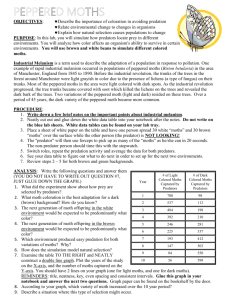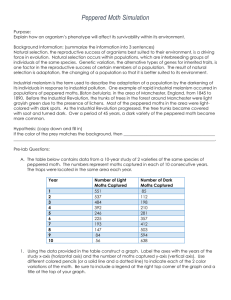Peppered Moth Graphing Activity: Natural Selection
advertisement
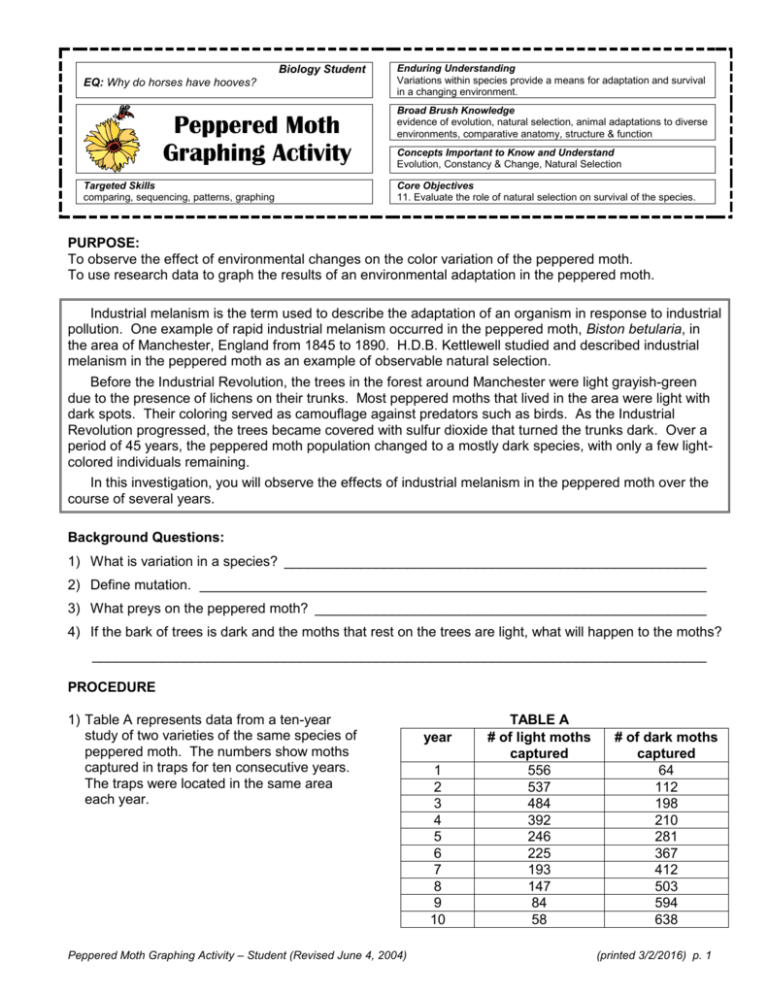
Biology Student EQ: Why do horses have hooves? Peppered Moth Graphing Activity Targeted Skills comparing, sequencing, patterns, graphing Enduring Understanding Variations within species provide a means for adaptation and survival in a changing environment. Broad Brush Knowledge evidence of evolution, natural selection, animal adaptations to diverse environments, comparative anatomy, structure & function Concepts Important to Know and Understand Evolution, Constancy & Change, Natural Selection Core Objectives 11. Evaluate the role of natural selection on survival of the species. PURPOSE: To observe the effect of environmental changes on the color variation of the peppered moth. To use research data to graph the results of an environmental adaptation in the peppered moth. Industrial melanism is the term used to describe the adaptation of an organism in response to industrial pollution. One example of rapid industrial melanism occurred in the peppered moth, Biston betularia, in the area of Manchester, England from 1845 to 1890. H.D.B. Kettlewell studied and described industrial melanism in the peppered moth as an example of observable natural selection. Before the Industrial Revolution, the trees in the forest around Manchester were light grayish-green due to the presence of lichens on their trunks. Most peppered moths that lived in the area were light with dark spots. Their coloring served as camouflage against predators such as birds. As the Industrial Revolution progressed, the trees became covered with sulfur dioxide that turned the trunks dark. Over a period of 45 years, the peppered moth population changed to a mostly dark species, with only a few lightcolored individuals remaining. In this investigation, you will observe the effects of industrial melanism in the peppered moth over the course of several years. Background Questions: 1) What is variation in a species? _______________________________________________________ 2) Define mutation. __________________________________________________________________ 3) What preys on the peppered moth? ___________________________________________________ 4) If the bark of trees is dark and the moths that rest on the trees are light, what will happen to the moths? ________________________________________________________________________________ PROCEDURE 1) Table A represents data from a ten-year study of two varieties of the same species of peppered moth. The numbers show moths captured in traps for ten consecutive years. The traps were located in the same area each year. Peppered Moth Graphing Activity – Student (Revised June 4, 2004) year 1 2 3 4 5 6 7 8 9 10 TABLE A # of light moths captured 556 537 484 392 246 225 193 147 84 58 # of dark moths captured 64 112 198 210 281 367 412 503 594 638 (printed 3/2/2016) p. 1 2) Using the data provided, make a graph comparing the numbers of each variety of peppered moth. Be sure that everything is labeled appropriately. (Use different colored pencils for light and dark moths.) (See the “Making a Graph” skill sheet for details on making and labeling graphs.) 700 650 600 550 500 450 400 350 300 250 200 150 100 50 0 0 1 2 3 4 5 6 7 8 9 10 DATA: QUESTIONS (Use your textbook and your graph to answer the following questions.) 3) Assume that, in the beginning, the peppered moths were all light colored. How did the dark coloring first occur in the moth population? ____________________________________________________ ________________________________________________________________________________ 4) What event caused the tree trunks of many trees in England to turn from light to dark? ___________ ________________________________________________________________________________ 5) Which variety of moth increased over the ten-year period? _________________________________ 6) What is the name of this type of evolutionary change? ____________________________________ ANALYSIS AND CONCLUSIONS 1. Explain the reason for the increase in the number of dark colored moths. _____________________ ________________________________________________________________________________ ________________________________________________________________________________ 2. Using the data on the graph, draw a conclusion about the population of peppered moths in the sampled area of England. ___________________________________________________________ ________________________________________________________________________________ ________________________________________________________________________________ 3. What could be done to return the environment of the peppered moth to its original state? _________ ________________________________________________________________________________ ________________________________________________________________________________ 4. What effect would cleaning up the environment have on the moths? _________________________ ________________________________________________________________________________ ________________________________________________________________________________ 5. Explain the peppered moth events in terms of natural selection. _____________________________ ________________________________________________________________________________ Peppered Moth Graphing Activity – Student (Revised June 4, 2004) (printed 3/2/2016) p. 2



